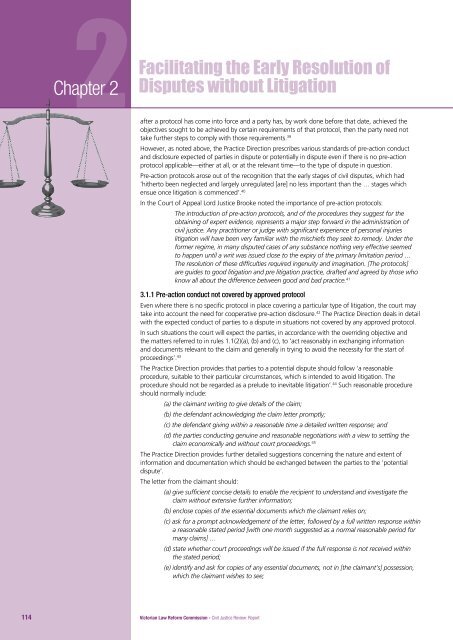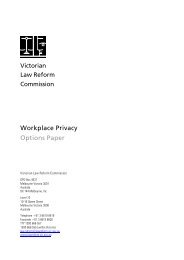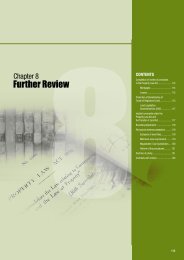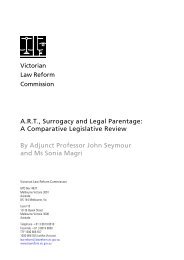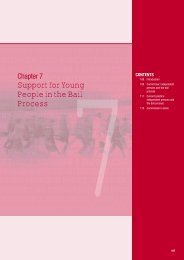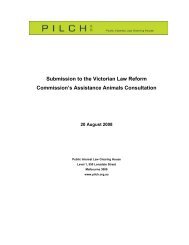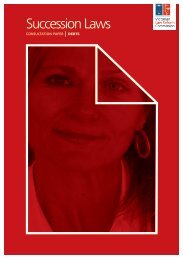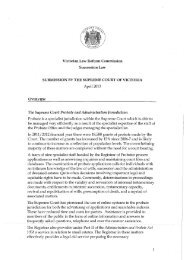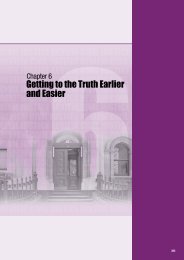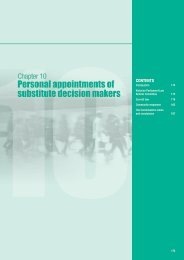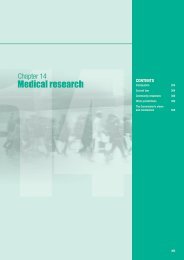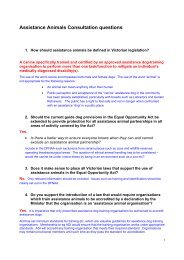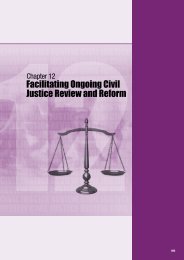Chapter 2<strong>Facilitating</strong> <strong>the</strong> <strong>Early</strong> <strong>Resolution</strong> <strong>of</strong><strong>Disputes</strong> <strong>without</strong> <strong>Litigation</strong>after a protocol has come into force and a party has, by work done before that date, achieved <strong>the</strong>objectives sought to be achieved by certain requirements <strong>of</strong> that protocol, <strong>the</strong>n <strong>the</strong> party need nottake fur<strong>the</strong>r steps to comply with those requirements. 39However, as noted above, <strong>the</strong> Practice Direction prescribes various standards <strong>of</strong> pre-action conductand disclosure expected <strong>of</strong> parties in dispute or potentially in dispute even if <strong>the</strong>re is no pre-actionprotocol applicable—ei<strong>the</strong>r at all, or at <strong>the</strong> relevant time—to <strong>the</strong> type <strong>of</strong> dispute in question.Pre-action protocols arose out <strong>of</strong> <strong>the</strong> recognition that <strong>the</strong> early stages <strong>of</strong> civil disputes, which had‘hi<strong>the</strong>rto been neglected and largely unregulated [are] no less important than <strong>the</strong> … stages whichensue once litigation is commenced’. 40In <strong>the</strong> Court <strong>of</strong> Appeal Lord Justice Brooke noted <strong>the</strong> importance <strong>of</strong> pre-action protocols:The introduction <strong>of</strong> pre-action protocols, and <strong>of</strong> <strong>the</strong> procedures <strong>the</strong>y suggest for <strong>the</strong>obtaining <strong>of</strong> expert evidence, represents a major step forward in <strong>the</strong> administration <strong>of</strong>civil justice. Any practitioner or judge with significant experience <strong>of</strong> personal injurieslitigation will have been very familiar with <strong>the</strong> mischiefs <strong>the</strong>y seek to remedy. Under <strong>the</strong>former regime, in many disputed cases <strong>of</strong> any substance nothing very effective seemedto happen until a writ was issued close to <strong>the</strong> expiry <strong>of</strong> <strong>the</strong> primary limitation period …The resolution <strong>of</strong> <strong>the</strong>se difficulties required ingenuity and imagination. [The protocols]are guides to good litigation and pre litigation practice, drafted and agreed by those whoknow all about <strong>the</strong> difference between good and bad practice. 413.1.1 Pre-action conduct not covered by approved protocolEven where <strong>the</strong>re is no specific protocol in place covering a particular type <strong>of</strong> litigation, <strong>the</strong> court maytake into account <strong>the</strong> need for cooperative pre-action disclosure. 42 The Practice Direction deals in detailwith <strong>the</strong> expected conduct <strong>of</strong> parties to a dispute in situations not covered by any approved protocol.In such situations <strong>the</strong> court will expect <strong>the</strong> parties, in accordance with <strong>the</strong> overriding objective and<strong>the</strong> matters referred to in rules 1.1(2)(a), (b) and (c), to ‘act reasonably in exchanging informationand documents relevant to <strong>the</strong> claim and generally in trying to avoid <strong>the</strong> necessity for <strong>the</strong> start <strong>of</strong>proceedings’. 43The Practice Direction provides that parties to a potential dispute should follow ‘a reasonableprocedure, suitable to <strong>the</strong>ir particular circumstances, which is intended to avoid litigation. Theprocedure should not be regarded as a prelude to inevitable litigation’. 44 Such reasonable procedureshould normally include:(a) <strong>the</strong> claimant writing to give details <strong>of</strong> <strong>the</strong> claim;(b) <strong>the</strong> defendant acknowledging <strong>the</strong> claim letter promptly;(c) <strong>the</strong> defendant giving within a reasonable time a detailed written response; and(d) <strong>the</strong> parties conducting genuine and reasonable negotiations with a view to settling <strong>the</strong>claim economically and <strong>without</strong> court proceedings. 45The Practice Direction provides fur<strong>the</strong>r detailed suggestions concerning <strong>the</strong> nature and extent <strong>of</strong>information and documentation which should be exchanged between <strong>the</strong> parties to <strong>the</strong> ‘potentialdispute’.The letter from <strong>the</strong> claimant should:(a) give sufficient concise details to enable <strong>the</strong> recipient to understand and investigate <strong>the</strong>claim <strong>without</strong> extensive fur<strong>the</strong>r information;(b) enclose copies <strong>of</strong> <strong>the</strong> essential documents which <strong>the</strong> claimant relies on;(c) ask for a prompt acknowledgement <strong>of</strong> <strong>the</strong> letter, followed by a full written response withina reasonable stated period [with one month suggested as a normal reasonable period formany claims] …(d) state whe<strong>the</strong>r court proceedings will be issued if <strong>the</strong> full response is not received within<strong>the</strong> stated period;(e) identify and ask for copies <strong>of</strong> any essential documents, not in [<strong>the</strong> claimant’s] possession,which <strong>the</strong> claimant wishes to see;114Victorian Law Reform Commission - Civil Justice Review: Report
(f) state (if this is so) that <strong>the</strong> claimant wishes to enter into mediation or ano<strong>the</strong>r alternativemethod <strong>of</strong> dispute resolution; and(g) draw attention to <strong>the</strong> court’s powers to impose sanctions for failure to comply with <strong>the</strong>practice direction and, if <strong>the</strong> recipient is likely to be unrepresented, enclose a copy <strong>of</strong> <strong>the</strong>practice direction. 46The Practice Direction also sets out in detail what is expected <strong>of</strong> defendants when <strong>the</strong>y receivenotification <strong>of</strong> a claim. The defendant should acknowledge <strong>the</strong> claimant’s letter in writing within 21days <strong>of</strong> receiving it. 47 The acknowledgement should state that <strong>the</strong> defendant will give a full writtenresponse. If <strong>the</strong> time for this is longer than <strong>the</strong> period stated by <strong>the</strong> claimant, <strong>the</strong> defendant shouldgive reasons why a longer period is necessary. 48In <strong>the</strong> full written response <strong>the</strong> defendant should, as appropriate:(a) accept <strong>the</strong> claim in whole or in part and make proposals for settlement; or (b) statethat <strong>the</strong> claim is not accepted [or if accepted in part clearly state] which part is acceptedand which part is not accepted. 49With a view to avoiding mere bare denials <strong>of</strong> liability, <strong>the</strong> Practice Direction suggests that where adefendant does not accept a claim in whole or in part, <strong>the</strong> written response should:(a) give detailed reasons why <strong>the</strong> claim is not accepted, identifying which <strong>of</strong> <strong>the</strong> claimant’scontentions are accepted and which are in dispute;(b) enclose copies <strong>of</strong> <strong>the</strong> essential documents which <strong>the</strong> defendant relies on;(c) enclose copies <strong>of</strong> documents asked for by <strong>the</strong> claimant, or explain why <strong>the</strong>y are norenclosed;(d) identify and ask for copies <strong>of</strong> any fur<strong>the</strong>r essential documents, not in [<strong>the</strong> defendant’s]possession, which <strong>the</strong> defendant wishes to see; and …(e) state whe<strong>the</strong>r <strong>the</strong> defendant is prepared to enter into mediation or ano<strong>the</strong>r alternativemethod <strong>of</strong> dispute resolution. 50In addition to <strong>the</strong> abovementioned provisions in relation to mediation and ADR, <strong>the</strong> Practice Directionmakes fur<strong>the</strong>r detailed provision for resolution <strong>of</strong> <strong>the</strong> dispute through alternative dispute resolution.The Practice Direction provides that parties should consider whe<strong>the</strong>r some form <strong>of</strong> ADR would bemore suitable than litigation and if so endeavour to agree which form to adopt. Both <strong>the</strong> claimant and<strong>the</strong> defendant may be required by <strong>the</strong> court to provide evidence that alternative means <strong>of</strong> resolving<strong>the</strong> dispute were considered, as <strong>the</strong> court takes <strong>the</strong> view that litigation should be a last resort. 51 ThePractice Direction outlines some <strong>of</strong> <strong>the</strong> options for resolving disputes <strong>without</strong> litigation: discussion andnegotiation; early neutral evaluation by an independent party; and mediation, which is described as‘a form <strong>of</strong> facilitated negotiation assisted by an independent neutral party’. 52 The Practice Directionexpressly recognises that no party can or should be forced to mediate or enter into any form <strong>of</strong> ADR. 53The Practice Direction provides that documents disclosed by ei<strong>the</strong>r party in accordance with <strong>the</strong>Practice Direction may not be used for any purpose o<strong>the</strong>r than for resolving <strong>the</strong> dispute unless <strong>the</strong>o<strong>the</strong>r party agrees. 54If an expert is needed, <strong>the</strong> Practice Direction provides that <strong>the</strong> parties should, wherever possible andto save expense, engage a mutually agreed upon expert, and warns that if <strong>the</strong> matter proceeds tolitigation <strong>the</strong> court may not allow <strong>the</strong> use <strong>of</strong> an expert’s report. Fur<strong>the</strong>rmore, its cost is not alwaysrecoverable. 55The Practice Direction states that where a person enters into a funding arrangement within <strong>the</strong>meaning <strong>of</strong> rule 43.2(1)(k) <strong>the</strong> party should inform o<strong>the</strong>r potential parties that a funding arrangementhas been entered into. 56Apart from <strong>the</strong> Practice Direction, <strong>the</strong> rules make provision for <strong>of</strong>fers <strong>of</strong> compromise to be madebefore proceedings are commenced, and where <strong>the</strong> <strong>of</strong>fer complies with <strong>the</strong> procedural requirements,<strong>the</strong> court will take that into consideration on <strong>the</strong> question <strong>of</strong> costs in any proceedings. 5739 Ibid, [5.3]. See also [5.4], where <strong>the</strong>noncompliance is because <strong>the</strong> timeperiod between <strong>the</strong> publication dateand <strong>the</strong> coming into force <strong>of</strong> <strong>the</strong>protocol was too short.40 Neil Andrews, English Civil Procedure:Fundamentals <strong>of</strong> <strong>the</strong> New Civil JusticeSystem (2003) [1.15].41 Carlson v Townsend [2001] 3 All ER663, 24, 28, 31.42 Ford v GKR Construction Ltd [2000] 1All ER 802, 810 (Lord Woolf MR).43 Ministry <strong>of</strong> Justice [UK] (2006), above n29, [4.1].44 Ibid, [4.2].45 Ibid.46 Ibid, [4.3].47 Ibid, [4.4].48 Ibid.49 Ibid, [4.5].50 Ibid, [4.6].51 Ibid, [4.7].52 Ibid.53 Ibid.54 Ibid, [4.8].55 Ibid, [4.9], [4.10].56 Ibid, [4A.1]; [4A.2] provides that thisapplies to all proceedings, whe<strong>the</strong>ror not a pre-action protocol applies.As <strong>the</strong> practice direction notes, r44.3B(1)(c) provides that ‘a party maynot recover [by way <strong>of</strong> costs] anyadditional liability for any period in <strong>the</strong>proceedings during which <strong>the</strong> partyfailed to provide information about afunding arrangement in accordancewith a rule, practice direction or courtorder’.57 See Civil Procedure Rules 1998 (SI1998/3132) r 36.10.115


